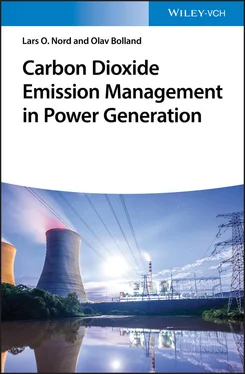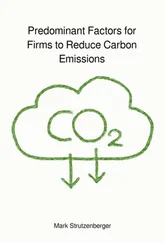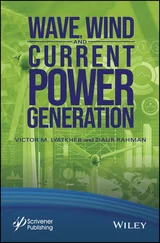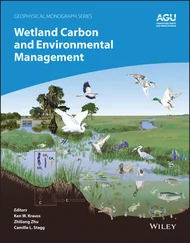The first chapter gives a general introduction on CO 2emissions and CO 2capture and storage (CCS). CCS also involves both CO 2transport and storage, and although not the focus of the book, Chapter 2gives an overview related to long-term storage of CO 2.
Before covering thermal power plant technologies in Chapter 5, both the fuels used in the power plants, and CO 2and its properties are covered in Chapters 3and 4, respectively. Chapters 6and 7deal with fundamentals of gas separation and plant efficiencies, important topics related to CO 2capture.
The CO 2capture methods are covered from Chapter 8and onwards, both in terms of gas separation methods, Chapters 9– 11, and capture processes integrated in power plants, Chapters 12– 14, dealing with pre-combustion, post-combustion, and oxy-combustion capture methods. Absorption is the most commonly used method to separate CO 2from gas mixtures. This method is discussed in separately in Chapter 9, while other methods, such as membranes and adsorption, are lumped together in Chapter 10.
This text was designed to bridge the gap between the many disciplines involved in CO 2capture and is fit for undergraduate students, graduate students, practicing process engineers, and others interested in an understanding and overview of CO 2 capture from thermal power plants in particular and of CCS in general. The research in the field is evolving and it is not the purpose of the book to cover all the latest developments and research within CCS. If this was the goal, the book would be outdated already at the time of publishing. For the latest in research, the reader is referred to review and research journal articles.
1 Introduction
1.1 Greenhouse Effect
The temperature in the Earth's atmosphere and at ground level is a result of a complex energy balance between incoming solar radiation energy and outgoing radiation energy from the Earth's surface and atmosphere. This balance varies naturally in daily and annual cycles. There are also variations with long-term cycles, such as the Milankovitch cycles, which are related to the Earth's orbital patterns (Milankovitch 1941). The heat balance is the basis for the temperatures that we have in the atmosphere and at ground level.
In general, the gases present in the atmosphere convert radiation energy into thermal energy – by absorption 1 of electromagnetic radiation , and vice versa – by radiation . The mechanism for absorption of radiation in a gas is that the gas molecules absorb the radiation energy by increasing its kinetic energy through molecular translation, rotation, and vibration, as well as electron translation and spin and nuclear spin. The increase in thermal energy of a gas translates into increased temperature. The longer the radiation travels through a gas, the more energy is converted. The radiation is at various wavelengths. The solar radiation is at rather low wavelengths (0.2–3 μm), either in the visible (0.4–0.8 μm) or in the near-visible (e.g. ultraviolet <0.4 μm) range. Radiation from the ground and from the atmospheric gases is at higher wavelengths (0.7–300 μm), which is known as infrared radiation.
The incoming solar radiation is about 342 W/m 2(IPCC-WG1 2007). Some of this is reflected back into space by clouds, aerosols 2 , and atmospheric gases, and some is reflected by the Earth's surface. About 240 W/m 2is absorbed by the Earth's surface and atmospheric gases. In order to have a heat balance with constant temperature, the radiation from the Earth must be the same. Most of the outgoing radiation energy is at wavelengths in the range of 7–15 μm. Radiation from a surface is temperature dependent (∝ T 4), and a radiation of 240 W/m 2would require an average surface temperature of −19 °C, which is much lower than the actual average Earth surface temperature of +14 °C. Because some of the outgoing radiation is absorbed by clouds or gases in the atmosphere, the temperature at which radiation takes place is forced from −19 °C to +14 °C to maintain the average flux of 240 W/m 2. This absorption of radiation and the related increase in temperature is known as the atmospheric greenhouse effect . This is different from the effect observed in greenhouses, where the temperature increase is caused by suppression of convection.
A key issue is that the gases in the atmosphere have different properties with respect to absorption of radiation and radiation from the gases themselves. The absorption of radiation in a gas depends on the wavelength. Ozone (O 3) is a gas that absorbs ultraviolet radiation very well, whereas CO 2absorbs at wavelengths around 3–5, and 12–20 μm. Water vapour absorbs at various wavelength ranges, including that of 7–15 μm. Visible light from the sun is absorbed by atmospheric gases only to a minor extent. The main bulk of infrared radiation, at wavelength 7–15 μm, is absorbed only to some extent. For some wavelength ranges, the absorption is about 100%.
The most important gases for the absorption of infrared radiation are water vapour (H 2O), carbon dioxide (CO 2), methane (CH 4), nitrous oxide (N 2O), halocarbons (gases containing fluorine, chlorine, and bromine), and ozone (O 3).
Water vapour is the most important greenhouse gas in the atmosphere, accounting for about 60% of the natural greenhouse effect for clear skies. Human activities influence the atmospheric water vapour content to only a small extent; it depends much more on the temperature. The relation between temperature and water vapour content in the atmosphere is approximately a constant relative to humidity. The greenhouse effect of water vapour is much stronger in humid areas around the equator compared to that in polar areas where the air humidity is very low. Consequently, the importance of CO 2as a greenhouse gas is more evident in polar regions, and changes in the concentration of CO 2have a larger impact on the temperature in these regions.
The two most abundant gases in the atmosphere – nitrogen and oxygen – contribute almost nothing to the greenhouse effect. Homonuclear diatomic molecules such as N 2, O 2, and H 2neither absorb nor emit infrared radiation.
The greenhouse effect was discovered by Joseph Fourier (1768–1830) in 1824. He was followed by John Tyndall (1820–1893), who did important work on the radiative properties of gases by verifying, through experiments, the absorption of radiation in gases and that emissions vary with wavelength and type of gas. In 1896, Svante Arrhenius (1859–1927) was the first to publish work on a quantitative investigation of the greenhouse effect, which he believed could explain the ice ages. At that time, the link between man-made emission of CO 2and climate change was already established. Even though the calculations by Arrhenius were shown to be erroneous, he cleverly managed to collect information from a large number of sources and to make predictions not so very different from those recently made by the IPCC. Guy Stewart Callendar (1898–1964) made a very important contribution with a publication (Callendar 1938) presenting a comprehensive global temperature time series and a model, linking greenhouse gases and climate change (Fleming 2007). He found that a doubling of atmospheric CO 2concentration resulted in an increase in the mean global temperature of 2 °C, with considerably more warming at the poles.
The effect of greenhouse gases in the atmosphere can be quantified on two different scales. One is the atmospheric lifetime, which describes how long it takes to restore the atmospheric system to equilibrium following a small increase in the concentration of the gas in the atmosphere. Individual molecules may interchange with the soil, oceans, and biological systems, but the mean lifetime refers to the net concentration change towards equilibrium by all sources and sinks. The other scale is the global warming potential (GWP), which is defined as the ratio of the time-integrated radiative forcing from a sudden release of 1 kg of a substance g relative to that of 1 kg of a reference gas, CO 2(IPCC-WG1 2007):
Читать дальше












